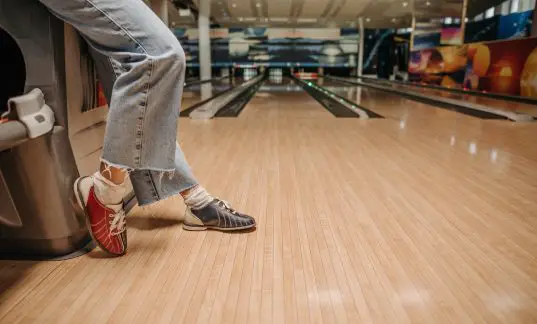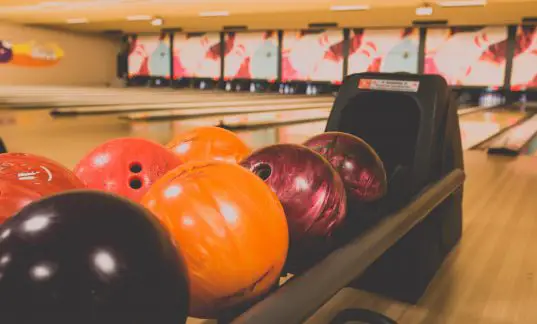For left-handed bowlers and right-handed bowlers alike, the value of a great hook shot is well documented. However, many bowlers aren’t able to throw a strong hook shot with powerful forward momentum while consistently hitting the pocket with efficacious force.
For these bowlers, throwing a straight ball into the pocket consistently can lead to more strikes and more sweet spot impacts than throwing a hook shot. While a straight bowler using a conventional grip might not have the points ceiling of a hook-dominant bowler, a straight shooter that eliminates unwanted rotation and heeds the following bowling tips can make noise at their local bowling alleys — be it during open bowling or league competition.
How do you bowl straight all the time?
To bowl straight with house balls or balls you own, you need to be mindful of your footwork, grip, and wrist positioning. Before stepping towards the foul line, make sure that your middle and ring fingers are comfortably slotted into the ball. At your starting position, stand straight and align your shoes with your pocket target. For a right-handed bowler, you should be aiming for the space between the head pin and the 3-pin. A left-handed bowler should shoot for the space between the head pin and the 2-pin.
When employing a standard four-step approach, approach the bowling lane in a straight line with your knees slightly flexed. Take your first step with the foot on the same side as your dominant hand — left foot for left-handed bowlers and right foot for right-handed bowlers.
Keep your bowling hand directed straight towards the target and your wrist straight. The ball’s trajectory when you release the ball should be a nearly direct track down the center of the lane towards your target. Your bowling arm follow-through and arm swing should be akin to an uppercut motion, with limited to no wrist rotation. Keep your torso parallel, straight, and directed towards the target.
Where do you aim when bowling a straight ball?
For a ball to be thrown straight, you don’t need to aim for the middle dot. After all, hitting the head pin straight on with your first ball can lead to all kinds of nasty splits. Aim your ball slightly right or left of the middle, towards your pin pocket. Veer to the second arrow on your dominant side and adjust as necessary if your ball hooks slightly and naturally.
Throw the ball in line with your target and try to guide your arm motion to and throw your target line.
What kind of bowling ball is best for straight bowlers?
We always recommend that serious bowlers use their own ball rather than a house ball. There are several advantages to doing this. One major advantage is having finger holes drilled for your particular fingers rather than using a house ball drilled for someone else.
As for ball composition, a straight bowler should use a bowling ball with a urethane or plastic coverstock to eliminate hook potential. If you get a slight angle or hook with a plastic ball, you know that it’s likely to be a throwing error and not a result of ball mechanics.
Also, use a heavy ball if you can for added force. Don’t overdo it, but don’t go too light. After all, you’re not getting the added benefit of increased entry angles and rotations that you’d get with a hook shot.
Do reactive resin bowling balls work for straight ball bowling?
It depends on the ball’s reactivity. The main difference between a reactive resin bowling ball and a plastic one is the porousness of the reactive ball’s coverstock. When a reactive resin ball travels down a lane, it’s absorbing oil the entire time for added friction and violence to and through the pins. And when you hook it, twisting your hand in a handshake position, you get all kinds of wild curves depending on the ball you use.
Whether you use your left hand or a ball designed for right-handers, it pays to use a ball tailored to your throwing style. Bringing a plastic or urethane ball to chest level offers less variance than a reactive ball when you’re trying to throw the ball straight.
Is it better to bowl straight or a curve?
While you have a better chance at light up the scoresheet with a great hook shot, it’s better to throw a ball in a manner that makes you comfortable. If you take a few steps and feel awkward completing a hook motion, you might need some practice before settling into a good curve. However, you might simply prefer a straight shot based on how your bowling arm and bowling hand feel when you throw.
And if you’re looking to pick up a single pin or two pins on a spare, a straight shot might be preferable for accuracy’s sake.
It just depends on what works for you. It’s harder to string consecutive strikes together with a straight shot, but it’s not impossible if you maintain form and hit the pocket consistently. Use your ring and middle finger to guide things, keep your arm straight, and don’t deviate from your straight line. You can make it happen!
Frequently Asked Questions
Why don’t you see pro bowlers throwing a ball straight?
The truth is that a straight ball doesn’t offer the scoring potential of a great hook shot. There are great straight bowlers out there in amateur competitions who can hold their own with hook bowlers. But, a straight shot just doesn’t have the oomph of a well-placed curve.
You will see professional bowlers who employ smaller curves or hooks that are much straighter in trajectory. That’s because they’re more comfortable with a smaller hook radius and enjoy the punch of a slighter curve. However, straight bowlers should look towards adding hooks to their arsenal before attempting to make a run at a professional career path.
What happens when you hit the head pin with a straight shot?
It depends on whether or not you hit the head pin straight on, clip it, or hammer it in the sweet spot of the pin pocket in conjunction with the 2 or 3 pin. If you hit a head pin directly with a straight ball, you might be in for some trouble. While you’re not guaranteed to leave a split with a lucky carom or enough force to spare, you increase your chances of a ghastly leave when you hit the 1-pin flush.
If you clip the head pin yet hit the pocket softly, you’re likely going to leave at least two or three pins — if not more. Hitting the head pin and pocket lightly with a straight ball can be a major problem. With a hook, you might get a bit more forgiveness. It’s not the same with a straight throw.
If you hit the head pin as part of a flush pocket shot, you could easily get a strike or a solid nine with the right force and placement.
Should you use a house ball to throw straight at your local bowling alley?
If you need to use a house ball, be sure to use a ball that works with your particular arm swing and throwing mechanics. Also, find a house bowling ball that doesn’t hurt your fingers or displace weight awkwardly when you throw it. Be mindful of your follow-through and the other straight ball bowling tips we highlighted above. And, be mindful of how your arm is affected by the house ball’s weight and layout. If it starts to hurt as your games progress, find another ball that’s easier to throw.
Closing Thoughts
While throwing bowling balls straight has its inherent problems, a good straight shot can still get you strikes and spares aplenty. Keep your form in mind, be solid with your footwork, and follow through with your target. Given time and practice, you can turn a straight ball into an impressive scoring average at your local bowling alley!

